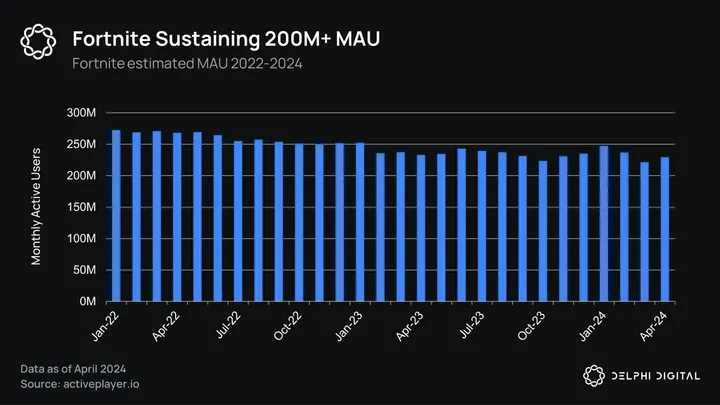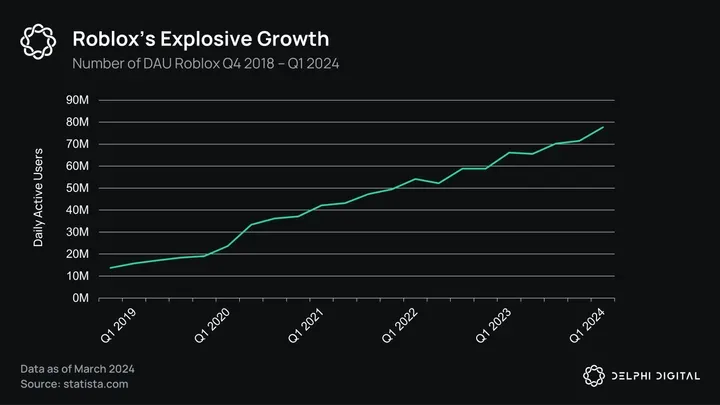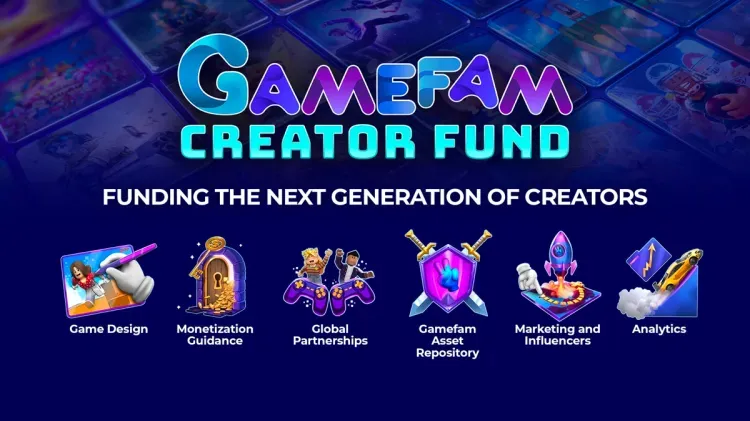Over the past 30 years, the gaming industry has undergone a remarkable transformation, evolving into a global entertainment leader with an estimated $184 billion in revenue in 2023 and a player base of around 3 billion. The widespread use of mobile devices, with Android users alone logging over 2.5 trillion hours of screen time in the first half of 2023, has lowered barriers to entry, bringing in millions of new gamers. As a result, game developers have turned to live operations (LiveOps) to maintain player engagement, with more than 60% of playtime spent on games older than six years.
This shift highlights the growing demand for fresh, user-generated content (UGC), which has become a key driver of long-term success in the gaming industry. Platforms like Roblox and Fortnite have harnessed the power of UGC, allowing players to create, share, and even monetize their content, setting the stage for the future of gaming, particularly with the rise of web3 technologies. In this article, we will break down data from a recent report by Delphi looking at UGC and web3.

The Rise of User-Generated Content in Gaming and Web3
Rise of User-Generated Content in Gaming
Advancements in game design tools have played a key role in enhancing how content is created. Major platforms like Roblox and Minecraft have tailored these tools, allowing users to generate their own content and even share in the profits. UGC has shifted from its modest beginnings, evolving into a major part of the gaming ecosystem. Hundreds of millions of players now enjoy games enriched by user-generated content, showcasing how UGC has transformed gaming into a more collaborative experience.
Modding: The Foundation of UGC
Modding, the foundation of UGC, dates back to the early days of gaming. In the 1980s, mods like Castle Smurfenstein, laid the groundwork for UGC. Modding was initially a challenging process, but id Software’s introduction of Doom WAD files in 1993 simplified it, making it easier for a broad community of creators to form. This ease of modification helped Doom reach an estimated 20 million players within just two years of its release.
Some of the most popular games in history originated from mods. Counter-Strike, for example, began as a Half-Life mod developed by a single coder in 2000, eventually becoming one of the biggest franchises with lifetime revenue exceeding $6.7 billion. Likewise, PlayerUnknown’s Battlegrounds (PUBG), a game that inspired the battle royale genre, started as a mod for ARMA 2, while DotA 2, one of the most played games of the last decade, originated from a mod of Warcraft III.
The modding community continues to thrive, particularly for games like Skyrim, which boasts over 69,000 mods available on Nexus and another 27,000 on Steam. These user-created modifications provide players with endless new content, helping to sustain player engagement long after a game’s initial release.

70k Mods Made for Skyrim Since 2011
Bottom-Up vs. Top-Down UGC Approaches
While LiveOps are essential for generating long-term revenue, they require considerable resources. To address this, some game studios have turned to UGC platforms to reduce costs by empowering their player communities to create content. Typically, this approach follows a bottom-up model, relying on an already established player base and game loop to unlock the full potential of UGC.
Fortnite's Bottom-Up UGC Strategy
Fortnite is a prime example of a bottom-up UGC approach. Initially launched in 2017 as a base-building and zombie-shooting game, Fortnite quickly evolved into a battle royale phenomenon. By September 2017, Epic Games introduced a new battle royale mode that capitalized on the base-building mechanic, attracting a massive player base. To keep up with demand, Epic Games introduced Fortnite Creative in 2018, a platform that allowed players to access no-code UGC tools to build and share their creations with others.
In 2023, the launch of Unreal Editor for Fortnite (UEFN) provided users with even greater freedom, granting full access to map creation. This expansion has led to the development of thousands of user-created maps, some of which attract over 50,000 daily active users. The success of Fortnite's UGC features underscores the importance of empowering communities to produce fresh content, ensuring continued player engagement.

Fortnite Sustaining 200M+ MAU
Roblox: A Top-Down UGC Platform
In contrast to Fortnite, Roblox adopted a top-down approach, focusing on UGC from the very beginning. Released in 2006, Roblox built its platform around the idea that users would create the majority of the content within its metaverse. Though this strategy required significant time and resources to develop, it has proven highly successful.
In 2019, Roblox achieved nearly $1 billion in revenue, and by 2023, that figure had more than doubled to $2.8 billion. The rapid growth of Roblox's user base reflects the success of this approach. By fostering a large-scale UGC ecosystem from the outset, Roblox has become a prime example of how the top-down model can be effective in creating a thriving gaming platform.

Roblox Explosive Growth
The Role of Web3 in UGC Gaming
As UGC continues to expand, the integration of web3 technologies is beginning to reshape the gaming landscape. With web3, players and creators alike can benefit from decentralized ownership models. Blockchain-based gaming platforms offer creators the ability to fully own and monetize their content, potentially transforming the revenue-sharing dynamics that exist today.
Moreover, the introduction of non-fungible tokens (NFTs) allows players to trade and sell in-game assets, opening up new avenues for player-driven economies within games. The concept of the metaverse, a virtual world where players can engage in various activities across multiple games, has also gained traction with the integration of web3. Platforms like Fortnite and Roblox are exploring the potential of web3 to enhance player experiences by providing more immersive, decentralized environments.

Roblox Key Art and Characters
Final Thoughts
The evolution of user-generated content (UGC) has reshaped the gaming industry, transforming players from passive consumers into active creators. From the early days of modding to the expansive platforms of Roblox and Fortnite, UGC has proven to be a key factor in sustaining long-term engagement and driving growth.
As web3 technologies continue to emerge, they are set to further enhance the gaming landscape, offering decentralized ownership and new monetization opportunities for both creators and players. By embracing UGC and the possibilities of web3, the gaming industry is positioned to create even more immersive, player-driven experiences that will define the future of interactive entertainment. You can read more in the full report here.



